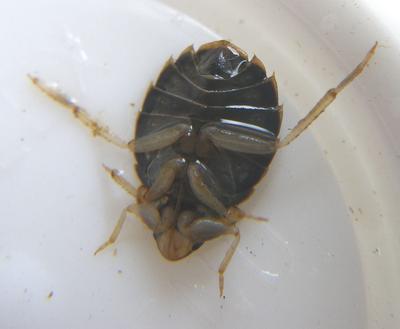 |
Aphelocheirus aestivalis underside. |
|
Aphelocheirus aestivalis |
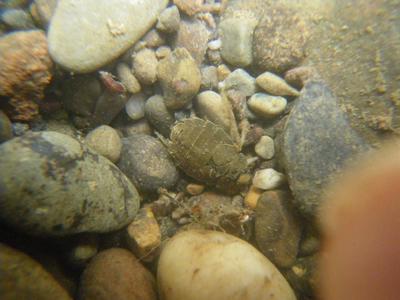 |
Worcestershire Record No. 27 November 2009 pp. 19-20
Harry Green
Don Goddard described finding the River Bug Aphelocheirus aestivalis in the River Teme in March 1997 in Worcestershire Record No 4, May 1998. This carnivorous bug is wholly aquatic with a plastron gill system enabling it to remain permanently under water unlike other aquatic bugs which periodically must rise to the water surface to collect air. It is usually found in medium-fast flowing rivers where the river bottom is of gravel or shingle with some silt and little vegetation. It hunts by swimming close to this substrate searching for small crustaceans. Its mouthparts consist of a long sharp sucking rostrum which it uses to impale its prey (or a finger if carelessly handled). The species occurs mainly in rivers in the southern half of England, throughout Wales, with scattered records further north.
On 28th August and 3rd of October 2009 five members of the Wyre Forest Study Group (who are all Worcestershire Recorders as well!) made their way down the River Severn, from Arley footbridge through Bewdley to Blackstone Rock. Our main objective was to get Mark Lawley to otherwise unreachable places in search of Bryophytes. Our transport, kindly arranged by Mike Averill, was an inflatable dingy; our power, four completely differently shaped paddles used out of unison by naturalists busy looking elsewhere. This proved an ideal craft for these two expeditions as water levels were so low we often grounded on mid stream rocks and shingle banks. However, we were hopeless at directing the boat in a straight line! While Mark searched for Bryophytes we took the opportunity to search for other wildlife.
Shortly before the first trip Brett Westwood had remembered Don Goddardís report of Aphelocheirus in the River Teme and came up with the idea of searching for it in the Severn. Poking about with suitable nets didnít reveal much until we stopped for a picnic on the large shingle bank by Trimpley Reservoir. Here we attempted kick sampling along the edge of the shingle bank and, much to our surprise, found the River Bug! Coincidentally, Don Goddard had found his specimens in the Teme during a family picnic! On our second boating expedition we parked on a shingle bank almost beneath the Bewdley by-pass bridge and again collected kick samples. Here were Caseless caddis larvae, mayfly nymphs, freshwater shrimps, but, we thought, no Aphelocheirus. However, I took a small sample of invertebrates home to identify and much to my astonishment amongst them was a rather less than full-grown nymph of Aphelocheirus aestivalis.
When fully developed Aphelocheirus is 8-12 mm long, brownish in colour, elliptical in shape, and very flattened top to bottom. The rostrum is long and usually held under the body. The tip reaches back to the bases of the middle legs. The wings are usually vestigial although winged forms may occur. In British waters the only similar animal is the Saucer Bug Ilyocoris cimicoides and this is usually an animal of weedy ponds or sluggish waters. It is also bigger, fully winged and with a shorter rostrum.
Following our expeditions we at first thought that Aphelocheirus was very scarce in Worcestershire and that our records and those of Don Goddard were the only ones. However, by accessing the NBN Gateway and drilling down into the data I found it had been recorded in 13 10x10km squares in Worcestershire (VC37). These comprise the whole of the River Severn from Tewkesbury to Arley, parts of the River Teme, one record from the River Avon above Evesham and another two near Redditch, presumably in the River Arrow. However the number of records is probably quite low and this animal is a scarce bug. Viewed at tetrad level the NBN maps show very few records in each 10x10 km square. While searching for Don Goddardís original article on the WBRC web site www.wbrc.org.uk using the search engine now installed by John Partridge I found another record! On a Worcestershire Recorders field recording day on 6th August 2005 to Arrow Valley Park in Redditch John Meiklejohn had found the species and the search engine found it in the published list of records ...
The distribution shown in the Provisional Atlas of British Aquatic Bugs (Huxley 2003) is very similar to that on the NBN Gateway. Further examination of the NBN data shows that it is mainly derived from data provided by The Environment Agency.
 |
Aphelocheirus aestivalis underside. |
|
Aphelocheirus aestivalis |
 |
Caddis and bivalves
Although all the aquatic invertebrates found on these boat journeys have not been identified the larvae of a Caseless web-spinning Caddis Hydropsyche pellucidula were found at the shingle banks. Also two large bivalve molluscs Anodonta anatina and Unio pictorum and a freshwater sponge not yet identified with certainty.
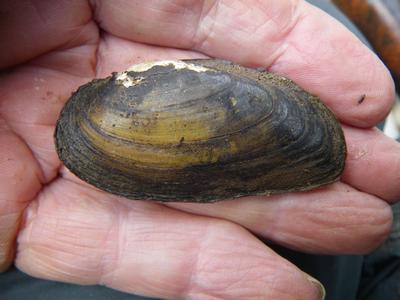 |
Unio pictorum |
|
Anodonta anatina |
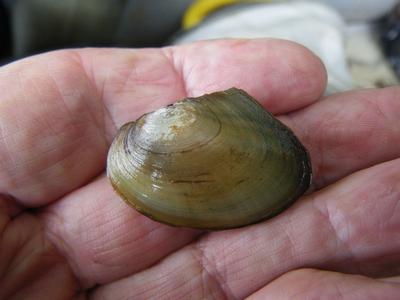 |
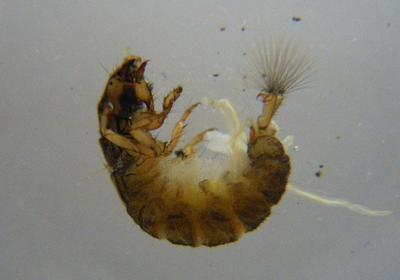 |
Hydropsyche
pellucidula |
Acknowledgements:
Expedition personnel were Mike Averill, Mark Lawley, Brett Westwood, Harry Green and Rosemary Winnall assisted by Phil Rudlin and Tony Winnall.
References and bibliography:
| EDINGTON JM & HILDREW AG 1995 Caseless Caddis larvae of the British Isles. Freshwater Biological Association (Key used to identify caddis larvae) | |
| GODDARD, DON, 1998 An unusual Water Bug From the River Teme: Aphelocheirus aestivalis (F). Worcestershire Record. 4:11, May 1998. | |
| HUXLEY, T, 2003. Provisional Atlas of the British aquatic bugs (Hemiptera, Heteroptera). Huntingdon, Biological Records Centre. | |
| KILLEEN I, ALDRIDGE D &OLIVER G, 2004. Freshwater Bivalves of Britain & Ireland. Field Studies Council. (Key used to identify bivalves) | |
| MEIKLEJOHN JW, 2005. Worcestershire Recorders & Worcestershire Biological
Records Centre Field Recording Days 2005 (Record of Aphelocheirus
aestivalis in list of records from Arrow Valley Park, Redditch). Worcestershire
Record. 19:68 et seq. November 2005. |
| WBRC Home | Worcs Record Listing by Issue | Worcs Record Listing by Subject |